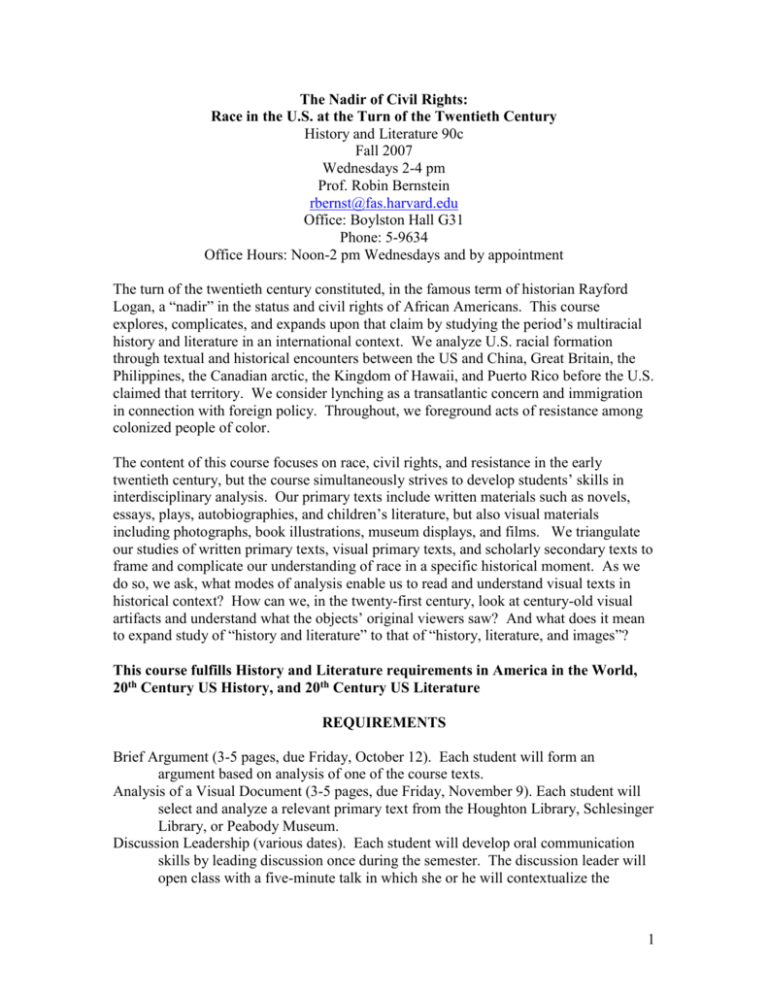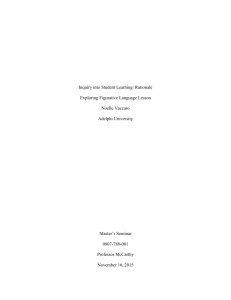The Nadir of Civil Rights
advertisement

The Nadir of Civil Rights: Race in the U.S. at the Turn of the Twentieth Century History and Literature 90c Fall 2007 Wednesdays 2-4 pm Prof. Robin Bernstein rbernst@fas.harvard.edu Office: Boylston Hall G31 Phone: 5-9634 Office Hours: Noon-2 pm Wednesdays and by appointment The turn of the twentieth century constituted, in the famous term of historian Rayford Logan, a “nadir” in the status and civil rights of African Americans. This course explores, complicates, and expands upon that claim by studying the period’s multiracial history and literature in an international context. We analyze U.S. racial formation through textual and historical encounters between the US and China, Great Britain, the Philippines, the Canadian arctic, the Kingdom of Hawaii, and Puerto Rico before the U.S. claimed that territory. We consider lynching as a transatlantic concern and immigration in connection with foreign policy. Throughout, we foreground acts of resistance among colonized people of color. The content of this course focuses on race, civil rights, and resistance in the early twentieth century, but the course simultaneously strives to develop students’ skills in interdisciplinary analysis. Our primary texts include written materials such as novels, essays, plays, autobiographies, and children’s literature, but also visual materials including photographs, book illustrations, museum displays, and films. We triangulate our studies of written primary texts, visual primary texts, and scholarly secondary texts to frame and complicate our understanding of race in a specific historical moment. As we do so, we ask, what modes of analysis enable us to read and understand visual texts in historical context? How can we, in the twenty-first century, look at century-old visual artifacts and understand what the objects’ original viewers saw? And what does it mean to expand study of “history and literature” to that of “history, literature, and images”? This course fulfills History and Literature requirements in America in the World, 20th Century US History, and 20th Century US Literature REQUIREMENTS Brief Argument (3-5 pages, due Friday, October 12). Each student will form an argument based on analysis of one of the course texts. Analysis of a Visual Document (3-5 pages, due Friday, November 9). Each student will select and analyze a relevant primary text from the Houghton Library, Schlesinger Library, or Peabody Museum. Discussion Leadership (various dates). Each student will develop oral communication skills by leading discussion once during the semester. The discussion leader will open class with a five-minute talk in which she or he will contextualize the 1 assigned texts and connect those texts with ones assigned earlier in the semester. The leader will then guide the conversation. Final Paper (12-15 pages, due January 14, 2008). Each student will conduct primary research and create an original argument of relevance to the course. Students are strongly encouraged to write final papers that engage visual evidence and/or incorporate an internationalist or transnationalist perspective. In preparation for writing the final paper, each student will hand in a prospectus on Friday, November 16. Grading: Productive participation, including active listening Brief Argument Analysis of a Visual Document Discussion Leadership Prospectus Final Paper 25% of final grade 10% of final grade 15% of final grade 15% of final grade 5% of final grade 30% of final grade The course assumes no previous knowledge of the historical era. The professor will provide an overall historical framework through brief weekly lectures. Students will take collective responsibility for the success of every discussion. This responsibility involves three components. First, you are required to arrive in class having read and thought about all the reading. In other words, merely gulping down the reading is inadequate. You should come to class having chewed and digested the material thoroughly. You are expected to prepare your own thoughts, opinions, and questions before every class. Second, you must listen actively to your classmates. Your contributions to our discussion should productively engage with your colleagues’ ideas. Third, you must express your thoughts in a respectful manner that advances our conversation. Practices that disrespect your colleagues (for example, interrupting, hogging the floor, launching personal attacks, or answering cell phones) will hinder conversation; such practices, therefore, are unacceptable. The prospectus is graded full credit/no credit. All papers are due to the History and Literature office by 3 pm of the due date. Late papers will be penalized one third of a letter grade for each day overdue. Failure to complete any assignment can lower your semester grade in excess of the stated percentage. Required Texts: Sourcebook (SB) Gail S. Bederman, Manliness and Civilization: A Cultural History of Gender and Race in the United States, 1880-1917 (Chicago: University of Chicago Press, 1996) Edgar Rice Burroughs, Tarzan of the Apes (1914) Charles W. Chesnutt, The Marrow of Tradition. 1901; reprint, edited and introduced by Eric J. Sundquist, New York: Penguin Books, 1993. Liliuokalani, Hawaii’s Story by Hawaii’s Queen (1898; reprint Honolulu, HI: Mutual Publishing, 1990) or online at <http://digital.library.upenn.edu/women/liliuokalani/hawaii/hawaii.html> 2 Brook Thomas, ed., Plessy v. Ferguson: A Brief History with Documents (New York: Bedford/St. Martin’s, 1997) Ida B. Wells (edited and introduced by Jacqueline Jones Royster), Southern Horrors and Other Writings: The Anti-Lynching Campaign of Ida B. Wells, 1892-1900 (Boston and New York: Bedford/St. Martins, 1997) Ida B. Wells, Frederick Douglass, et al., The Reason Why the Colored American is Not at the World’s Columbian Exposition (1892, ed. by Robert W. Rydell, 1999) or online <http://digital.library.upenn.edu/women/wells/exposition/exposition.html> Films: Birth of a Nation (D.W. Griffith, 1915) Nanook of the North (dir. Robert J. Flaherty, 1922) COURSE SCHEDULE September 19. Introduction Read and discuss in class: W. E. B. Du Bois, The Souls of Black Folk (1903), “The Forethought” and “Of Our Spiritual Strivings” View and discuss in class: Stereographs from the 1893 Columbian Exposition, the 1904 Louisiana Purchase Exposition, and the 1915 Panama Pacific International Exposition September 26. The 1893 Columbian Exposition and the Turner Thesis Frederick Jackson Turner, “The Significance of the Frontier in American History”(1893) <http://xroads.virginia.edu/~HYPER/TURNER/chapter1.html> Ida B. Wells, Frederick Douglass, et al., The Reason Why the Colored American is Not at the World’s Columbian Exposition (1892, ed. by Robert W. Rydell, 1999) <http://digital.library.upenn.edu/women/wells/exposition/exposition.html> Robert W. Rydell, All the World’s a Fair: Visions of Empire at American International Expositions, 1876-1916 (Chicago, IL and London: The University of Chicago Press, 1984), chapter 2, “The Chicago World’s Columbian Exposition of 1893: ‘And Was Jerusalem Builded Here?’” pp. 38-71 (SB) October 3. “Vanishing Indians”? Zitkala-Sa, “Impressions of an Indian Childhood,” “The School Days of an Indian Girl, “An Indian Teacher Among Indians,” “Side by Side,” 1896-1902. In Zitkala-Sa, American Indian Stories, Legends, and Other Writings, Cathy N. Davidson and Ada Norris, eds. (New York: Penguin Books, 2003), pp. 68-113. (SB and available online through Hollis) Zitkala-Sa, The Sun Dance Opera (1904) from P. Jane Hafen, ed., Dreams and Thunder: Stories, Poems, and The Sun Dance Opera (Bison Books, 2005) (SB) Joy Kasson, Buffalo Bill’s Wild West: Celebrity, Memory, and Popular History (New York: Hill and Wang, 2001), chapters 3 and 5, “At the Columbian Exposition, 1893” (pp. 93-122) and “American Indian Performers in the Wild West” (161-220) (SB) Laura Wexler, “Tender Violence: Domestic Photographs, Domestic Fictions, and Educational Reform.” In Tender Violence: Domestic Visions in an Age of U.S. 3 Imperialism (Chapel Hill, NC: University of North Carolina Press, 2000), pp. 94-126. (SB) October 10. The Annexation of Hawaii, 1893-1898 Liliuokalani, Hawaii’s Story by Hawaii’s Queen. (online at <http://digital.library.upenn.edu/women/liliuokalani/hawaii/hawaii.html> Noenoe K. Silva, “The Antiannexation Struggle” and “The Queen of Hawai’i Raises Her Solemn Note of Protest,” in Aloha Betrayed: Native Hawaiian Resistance to American Colonialism (Durham, NC: Duke University Press, 2004), pp. 123-203 (SB) Friday, October 12: Brief Argument due by 3 pm to Prof. Bernstein’s mailbox in the History and Literature Office October 17. Transatlantic Resistance to Lynching Ida B. Wells, Southern Horrors and Other Writings (edited by Jacqueline Jones Royster) Gail S. Bederman, Manliness and Civilization: A Cultural History of Gender and Race in the United States, 1880-1917 (Chicago: University of Chicago Press, 1996) chapter 2: “‘The White Man’s Civilization on Trial’: Ida B. Wells, Representations of Lynching, and Northern Middle-Class Manhood” (pp. 45-76) October 24. The Violence of Segregation Selections, Brook Thomas, ed., Plessy v. Ferguson: A Brief History with Documents (New York: Bedford/St. Martin’s, 1997) Charles W. Chesnutt, The Marrow of Tradition. 1901; reprint, edited and introduced by Eric J. Sundquist, New York: Penguin Books, 1993. October 31. Theodore Roosevelt and the Spanish-American War Theodore Roosevelt, The Strenuous Life: Essays and Addresses (1900; online at <http://www.bartleby.com/58/>) Bederman, ch. 5, “Theodore Roosevelt: Manhood, Nation, and ‘Civilization’” (pp. 170-215 Amy Kaplan, “Black and Blue on San Juan Hill” (in Amy Kaplan and Donald E. Pease, eds., Cultures of United States Imperialism (Durham, NC: Duke University Press, 1993) Donna Haraway, “Teddy Bear Patriarchy: Taxidermy in the Garden of Eden, New York City, 1908-1936” (in Amy Kaplan and Donald E. Pease, eds., Cultures of United States Imperialism (Durham, NC: Duke University Press, 1993) November 7. Occupation and Resistance in the Philippines Aurelio Tolentino, Luhang Tagalog (Tagalog Tears). 1902. From Arthur Stanley Riggs, The Filipino Drama (1905; reprint, Manila: Ministry of Human Settlements Intramuros Adminstration, 1981), pp. 62-119. (SB) View the following photographs from The Book of the Fair, 1904: 4 • The Filipino of Yesterday <http://www.boondocksnet.com/gallery/wfe1904/wfe04ww5133a.html> • The Filipino of Today <http://www.boondocksnet.com/gallery/wfe1904/wfe04ww5133b.html> • Dance of the Igorots <http://www.boondocksnet.com/gallery/wfe1904/wfe04ww5135a.html> • All Is Vanity: An Igorrote Maid <http://www.boondocksnet.com/gallery/wfe1904/wfe04bf041.html> • Moro Chief in Full Dress <http://www.boondocksnet.com/gallery/wfe1904/wfe04bf042.html> • Igorrote Warrior Ready for the Fray <http://www.boondocksnet.com/gallery/wfe1904/wfe04bf044.html> • An Igorrote Chief at the Exposition <http://www.boondocksnet.com/gallery/wfe1904/wfe04bf047.html> • A Native of the Philippines at the World's Fair <http://www.boondocksnet.com/gallery/wfe1904/wfe04bf305.html> • A Filipino Belle <http://www.boondocksnet.com/gallery/wfe1904/wfe04bf306.html> • Moro Chief Posing at the World's Fair <http://www.boondocksnet.com/gallery/wfe1904/wfe04bf307.html> • Two Moro Fashion Plates <http://www.boondocksnet.com/gallery/wfe1904/wfe04bf455.html> • Savage Musicians and Dancers <http://www.boondocksnet.com/gallery/wfe1904/wfe04bf261.html> Palmer Cox, The Brownies in the Philippines (New York: The Century Company, 1904). “The Brownies on Mindoro,” “The Brownies on Romblon,” “The Brownies on Luzon,” “The Brownies at Manila Bay,” “The Brownies on Negros,” pp. 1-7, 22-29, 54-60, 85-92, 127-133 (SB) Vincente L. Rafael, “White Love: Surveillance and Nationalist Resistance in the U.S. Colonization of the Philippines” (in Amy Kaplan and Donald E. Pease, eds., Cultures of United States Imperialism (Durham, NC: Duke University Press, 1993) Friday, November 9: Analysis of a visual document due by 3 pm to Prof. Bernstein’s mailbox in the History and Literature Office November 14. Immigration and Anti-Immigration Sui Sin Far—selections tba Arnold Genthe and John Kuo Wei Tchen, Genthe’s Photographs of San Francisco’s Old Chinatown (Dover, 1984) Randolph Bourne, “Transnational America” (1916) Available online at http://www.swarthmore.edu/SocSci/rbannis1/AIH19th/Bourne.html Matthew Frye Jacobson, Barbarian Virtues: The United States Encounters Foreign Peoples at Home and Abroad, 1876-1917 (New York: Hill and Wang, 2001) (excerpts in SB) 5 RECOMMENDED: Bederman chapter 4: “‘Not to Sex—But to Race!’ Charlotte Perkins Gilman, Civilized Anglo-Saxon Womanhood, and the Return of the Primitive Rapist” (pp. 121-169) Friday, November 16: Prospectus for final paper due to Prof. Bernstein’s mailbox in History and Literature office by 3 pm November 21. Founding the NAACP W. E. B. Du Bois, excerpts from The Souls of Black Folk (1903) (SB) Selections from The Crisis magazine (SB) Selections from The Brownies’ Book (SB) November 28. Gender, Technology, and Conquest Film: Nanook of the North (dir. Robert J. Flaherty, 1922) Robert J. Flaherty, “How I Filmed ‘Nanook of the North,’” World's Work, October 1922, pp. 632-640 (SB). Laura Wexler, “What a Woman Can Do with a Camera.” In Tender Violence: Domestic Visions in an Age of U.S. Imperialism (Chapel Hill, NC: University of North Carolina Press, 2000), pp. 15-51. (SB) REVIEW materials on Theodore Roosevelt December 5. Spectacles of Death Film: Birth of a Nation (D.W. Griffith, 1915) Angelina Weld Grimké, Rachel (1916). Available online through Hollis at http://lms01.harvard.edu/F/JA8CSHYF5CGNYTXN9395H6YNHGG1I6BCFDP7L3 3G77A377J1RY-14615?func=full-setset&set_number=734411&set_entry=000002&format=999 Jacqueline Goldsby, A Spectacular Secret: Lynching in American Life and Literature (Chicago, IL and London: The University of Chicago Press, 2006), chapter 6, “In the Mind’s Eye,” pp. 282-307 (SB) Harry J. Elam, Jr. “Reality ” in Janelle G. Reinelt and Joseph R. Roach, eds., Critical Theory and Performance, Revised and Enlarged Edition (Ann Arbor, MI: University of Michigan Press, 2007), pp. 173-190 (SB) December 12. The King of the Jungle Edgar Rice Burroughs, Tarzan of the Apes (1914) John F. Kasson, Houdini, Tarzan, and the Perfect Man: The White Male Body and the Challenge of Modernity in America (New York: Hill and Wang, 2001), chapter 3, “‘Still a Wild Beast at Heart’: Edgar Rice Burroughs and the Dream of Tarzan,” pp. 157-218 (SB). Bederman, “Conclusion: Tarzan and After,” pp. 217-239 Monday, January 14, 2008: Final paper due to Prof. Bernstein’s mailbox in the History and Literature office by 3 pm 6









